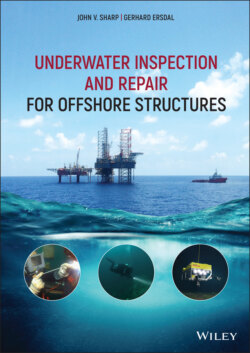Читать книгу Underwater Inspection and Repair for Offshore Structures - Gerhard Ersdal - Страница 18
1.3.3 Concrete Platforms
ОглавлениеConcrete is used in several different types of offshore structures, which include:
gravity‐based structures, or GBS (for example, the Norwegian platforms Statfjord A‐C and UK platform Brent C);
tension leg platforms, or TLP (the Norwegian platform Heidrun);spar platforms, particularly for wind energy production,
semi‐submersible platforms (the Norwegian platform Troll B);
Jarlan walls enclosing concrete tanks (the UK platform Ninian and the Norwegian platform Ekofisk Tank);
steel‐concrete hybrid (the UK platform Ravenspurn); and
articulated tower (used as a loading column on Maureen).
The first concrete structure to be installed in the Norwegian sector was the Ekofisk tank in 1973 and the first to be installed on the UKCS was Beryl Alpha in 1975. At the time of writing, there are 22 concrete gravity‐based platforms, together with one concrete tension leg platform (Heidrun), one concrete semi‐submersible platform (Troll B) and one concrete base for a steel upper section (Harding).
Due to the dominance of GBS‐type structures, this book will mainly focus on these, but some aspects will apply for all types of concrete structures. The main parts of a concrete gravity‐based structure (GBS) are:
legs, towers and shafts;
storage cells (caissons);
steel‐to‐concrete transition;
shaft‐to‐base junction;
prestressing anchorages;
splash zone;
foundations; and
cathodic protection system.
Most concrete structures rest on the seabed on a large caisson often with skirts that penetrate the seabed protecting the structure against horizontal and overturning forces (Figure 4 c). The size of the caisson and skirts depends on local soil conditions. The topside steel structure is usually supported on up to four concrete columns/shafts extending from the caisson through the sea surface. The caisson can be divided into cells, which may be used as compartments for oil storage or as ballast. One or two of the columns are usually drill shafts supporting conductor frames and well‐conductors. Some of the shafts, which may be water filled or dry, are normally outfitted mechanically.
